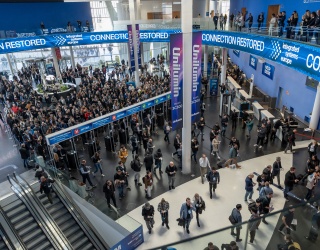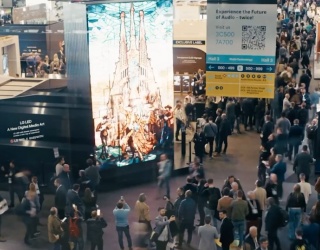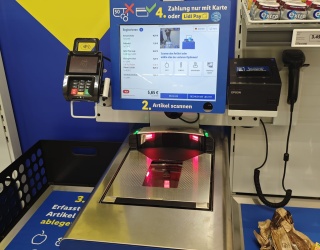Throughout the world – and South Africa is no exception – the key phrase when discussing CCTV is definitely ‘Go Digital’. There is no longer any question that old analogue-based systems will eventually be replaced with the new digital technology available today.
But, as MJ Oosthuizen, Product Manager: Transmission and Mobile Technology at Norbain SA explains: “Norbain has pioneered digital CCTV technologies in South Africa, so we have a deep understanding of the issues confronting customers. Common questions which arise are where, in the complex chain of camera to recording, can we implement digital technology? Why change analogue systems that are still working? What benefits will be delivered and at what cost? And, most importantly, has the time arrived to implement digital solutions?”
CCTV performance has been severely restricted by International video standards that evolved out of the development of television, but these standards have not always been beneficial to CCTV applications. “CCTV manufacturers have gone to great lengths to get the best possible performance from this historic situation, but this time has passed. The CCTV industry is rapidly breaking these chains and moving forward - it is now positioned to move entirely into the digital domain, following broadcasting, telecommunications, the recording industry and printing industries,” explains Oosthuizen.
Signal Strengths: Analogue vs Digital
An analog/analogue signal is an ‘any time continuous signal’ where some time varying features of the signal is a representation of some other time varying quantity. It differs from a digital signal in that small fluctuations within the signal are meaningful. Analog is usually thought of in an electrical context, however mechanical, hydraulic, and other systems might also transmit analog signals. Each stage of the process, from camera through cabling, switching/multiplexing, recording and finally display, involves a transfer of this signal with unavoidable loss in both accuracy, and quality. On the other hand, digital signals are represented by binary numbers, through a series of 0’s and 1’s in relevant order, and this precision of quantity is measured in bits. Oosthuizen adds: “A digital signal is transferred through each of these stages with total precision, because each tiny element of the signal is represented by a number. Transmissions are coded, so that errors can be detected and corrected, or part of the signal can be repeated. Ideally, video signals need to be generated in a digital format, and then processed from start to finish in the digital domain to avoid the initial loss of accuracy that would occur were the signal initially to be converted from analogue input into. This is exactly the trend current CCTV systems are following.”
Begin at the Beginning: Truly Digital Cameras
CCTV camera manufacturers have caused a big buzz through their marketing of so called ‘digital cameras’. Oosthuizen explains: “Virtually none of these cameras are truly digital - they merely have internal digital processing to produce a better picture, alternatively a digital interface for camera control, but they do NOT produce a true digital image output.“
True digital cameras discard the normal analogue video standard, and at the same time all the problems of fixed frame rate, interlacing, interlace motion-blur, limited TV-line resolution, and loss of signal quality over distance. Digital cameras will produce a digital signal with a frame rate and resolution most suited to the application, and can vary this according to immediate needs. These cameras can switch rapidly from a high-framerate, medium-resolution image, to very high-resolution snapshots, or to lowframerate, low-resolution output for video transmission over phone lines. By using non-interlaced progressive scanning, digital cameras immediately DOUBLE the available vertical resolution for recording purposes. Digital cameras will also offer far more than just better resolution and image quality - they will be intelligent. Oosthuizen explains: “Their on-board processors and memory storage will mean that, with suitable programming, they could switch on lights, detect motion, trigger alarms, open gates, close doors and record pre- and post-alarm images when required. They will also be capable of controlling their own Pan Tilt and Zoom (PTZ) mounts, triggering automatic wash/wipe functions(to clean camera lenses), and even remind system managers when scheduled maintenance is due. Several manufacturers already offer cameras that have many of these features, but developments are still in the pipeline to fully exploit the benefits that digital technology offers in CCTV cameras.”
Sending the Right Message: Local transmission
Camera signals have to be transmitted and received together in a control room, or other central point, for recording, observation and control. Oosthuizen explains: “Analogue video is transmitted over coaxial cable, or twisted-pair cable with special converters at each end. When analogue cable is used, problems do occur, such as signal loss, interference, noise, and general loss of video quality. Fibre-optic transmission, although expensive, is now common on many larger sites, but the signals are usually digitised first, and reconverted at the receiving end – not always the ideal solution. “With true digital cameras, the images will be transmitted on various types of data cable (including fibre-optic), but the most common will be standard CAT5 cable, using Ethernet networking protocols.”
Ethernet is the most common networking standard for modern computer systems, therefore easily exploited for CCTV applications. Digital data transmission results in zero loss of signal quality. “Digital cameras may well have on-board image compression, reducing the data transmitted, thereby utilizing network bandwidth more efficiently,” adds Oosthuizen.
Choosing the View: Telemetry
Telemetry, being the control of PTZ and other camera functions, adds further complications to the analogue domain. In some cases separate cabling must be used, which is expensive and time consuming, alternatively the telemetry signals must be transmitted alongside the video signals, further reducing picture quality.
Most CCTV control system manufacturers have developed their own telemetry protocols – some better than others - but compatibility issues can arise when different makes of equipment are used together in the same system, a situation to avoid at all costs. Oosthuizen comments further: “In the digital domain, telemetry signals are just additional data, and can be freely mixed with image data from the cameras without interference or problems associated with signal protocols. Furthermore, the flexibility of digital data transmission is such that further system functions can be added at any time, simply by modifying the software.”
Chopping and Changing: Multiplexers
Multiplexers digitise incoming analogue camera video signals. They then synchronise them by interleaving fields from different cameras and re-converting the digital data back to analogue for recording by an analogue VCR. Oosthuizen comments: “So internally, a multiplexer already exploits digital technology, but in a rather half-hearted manner. Once digitised, why convert the data back to analogue with a further loss of quality!” Digital video recorders already integrate most of the functions of VCRs and multiplexers, with the result that most manufacturers are phasing out multiplexers due to the extremely low demand.
Keeping the Record Straight: Recorders
Analogue video recorders have been around for a long time, as have the problems associated with them: recorded image quality is limited; tapes and heads wear out and maintenance is expensive. Tapes must be changed daily, be properly labelled and stored, and specific recorded sequences are tedious and time-consuming to find.
Digital recording overcomes all of these problems. The benefits of digital recording are already well-documented, but to summarise they include:
- Consistent image quality
- Automatic, flexible recording schedules
- Instant response to alarm inputs, including pre-alarm recording
- Higher recorded resolution
- Variable frame rates, resolutions, and camera sequences, according to times and dates
- Instant retrieval and playback of recorded sequences
- Simultaneous playback whilst recording
- No loss of image quality when duplicating recordings
- Fast, low-cost duplication
“Some applications may still be better suited to analogue on grounds of cost or long-term archiving requirements, but these considerations already belong to the past,” adds Oosthuizen. Digital recording benefits are compromised if they are receiving input from analogue CCTV cameras. Oosthuizen comments: “As we move towards all-digital systems, digital video recorders will simply collect and store the no digitised signal from the cameras, at whatever frame rate and resolution the camera is required to produce at the time.”
Cool Viewing: Displays
Even the good old analogue video monitor screen is not safe from the advancing army of digital technologies. Video monitors are bulky, heavy, consume a lot of power and produce a lot of heat. Oosthuizen adds: “In SA, there is still a tendency for price to win out over quality, but as fullydigital systems become the norm, this will change.”
Flat-screen LCD displays are, by their very nature, digital. Each square point on the screen is an individually addressed pixel. Many of these screens now have direct digital interfaces so that the graphic display is generated directly from a computer.
Joining Up The Dots: Remote transmission & control
Once a CCTV picture is in a digital format, it is effortlessly transmitted over traditional telephone networks, modern cellular or wireless networks, ISDN or data networks. The same applies to telemetry signals. “The advantages of digital technology for remote control and picture transmission are so overwhelming, that all video transmission systems that offer this functionality now use digital technology,” comments Oosthuizen. As CCTV systems integrate more elements of digital technology, the capability and flexibility of remote-control systems will increase substantially.
Evolve into the Digital Future
Oosthuizen concludes: “It is now a fact: CCTV systems can be fully digital. There is no longer any question about whether CCTV systems will become fully digital or not: it only remains a question of how and when. There are many intermediate steps on this path, as discussed above, but digital technology is rapidly overtaking analogue technology in all areas of CCTV”. Remote transmission and control systems are all digital (Windows-based or embedded systems such as Linux). Recording is rapidly changing as the power and flexibility of digital recording becomes more widely understood and accepted. Cameras already contain a lot of digital processing technology, and many already feature fully digital outputs and direct network connections. “In the very near future it may become impossible to tell the difference between a CCTV system, and a computer network. Even today, one is just as likely to meet the IT manager as the Security manager when discussing CCTV applications for larger organisations. “There is no point in waiting for the ‘ultimate’ solution: development will always be ongoing. The key to successfully evolving into a modern digital CCTV solution is to ensure that you select a properly designed system that has the flexibility to easily incorporate the next round of developments.”
By MJ Oosthuizen, Product manager at Norbain SA.
(Norbain SA is HeiTel’s exclusive partner in the South African market)











